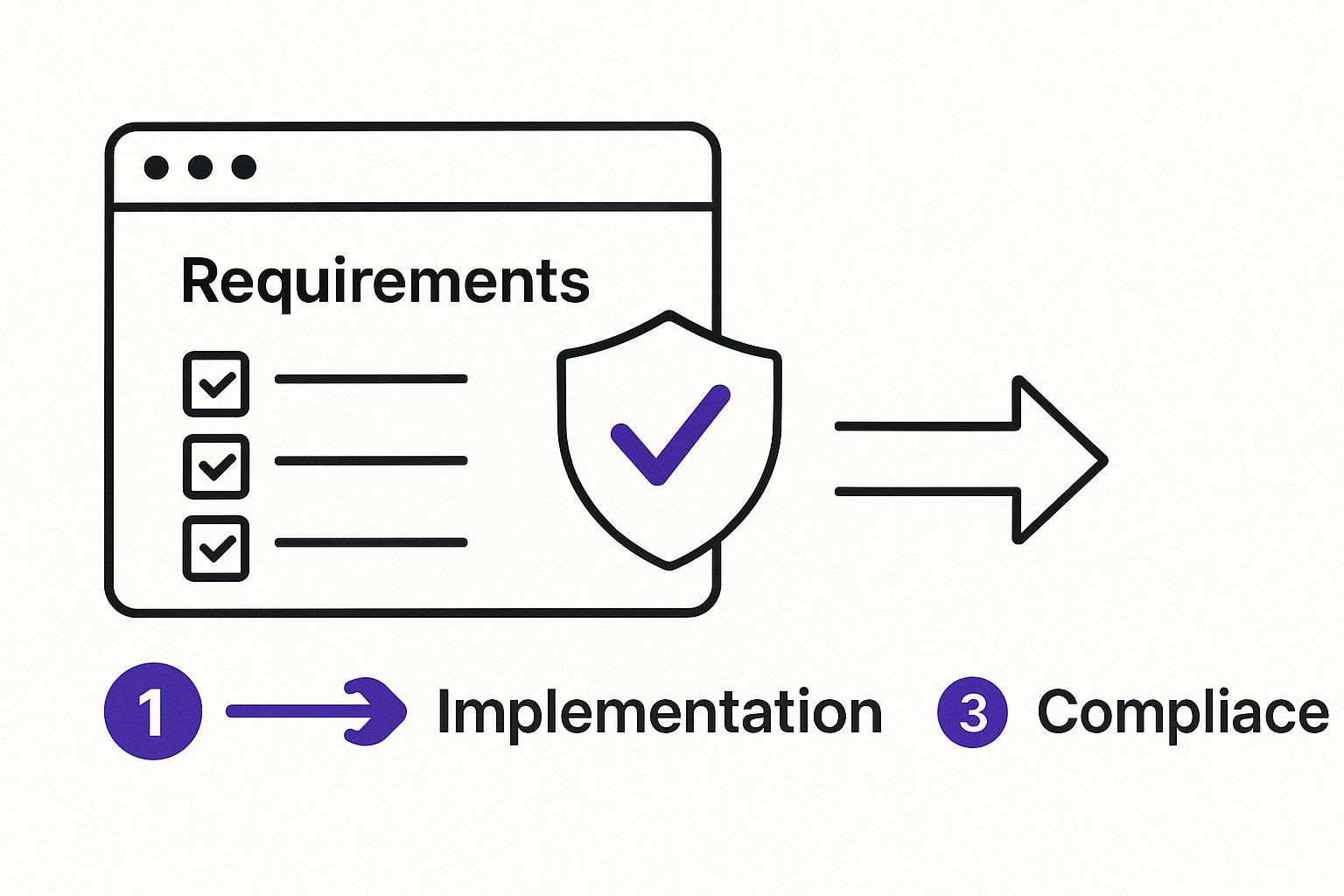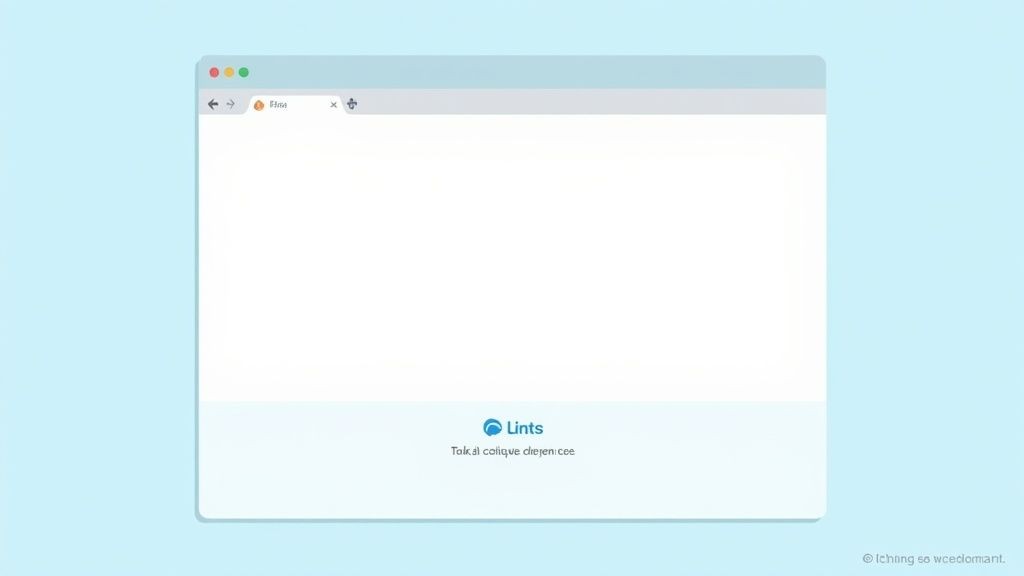Getting your website GDPR compliant isn't just about ticking a legal box. It's about earning your visitors' trust by being transparent and respectful with their data. This means getting clear consent, having a straightforward privacy policy, and making sure every tool you use on your site plays by the same strict rules.
Decoding GDPR for Your Website
Let's be honest, the General Data Protection Regulation (GDPR) can feel like a maze. But at its heart, the mission is simple: protect user data. For anyone with a website, this is less of a legal headache and more of a chance to build real trust with your audience.
Before we dive into the nitty-gritty, it's worth remembering what a modern website really is. It’s your digital storefront, your main office, your primary marketing channel. Every single interaction, from a casual page view to a contact form submission, can involve personal data. That’s why understanding why every business owner needs a website is the first step - the second is protecting the people who visit it.
So, what exactly is "personal data" under GDPR? It’s not just the obvious stuff like names and emails. The net is cast much wider and includes things like:
- IP Addresses: The unique address for a user's device.
- Cookie Data: Those little files tracking user behavior and preferences.
- Geolocation Data: Information about where a user is physically located.
- Device IDs: The unique number assigned to a user's phone or tablet.
Basically, if a piece of information can be used to identify a living person - either by itself or combined with other data - GDPR has it covered.
Key Principles You Need to Know
The entire regulation is built on seven core principles. Think of these as the pillars holding up your entire compliance strategy. They're your guide for every single data-related action on your site.
At the top of the list is the idea that you must have a legitimate reason for collecting data, which the regulation calls a lawful basis for processing. For most websites, the most common basis you'll rely on is user consent. And this can't be just any consent. It has to be freely given, specific, informed, and unambiguous.
This means the days of pre-checked boxes and assuming consent just because someone is browsing your site are long gone. You need a clear "yes."
A common myth is that GDPR only matters for big corporations. The reality is that the regulation applies to any website, big or small, that processes the personal data of individuals in the European Union.
To make these principles easier to digest, here’s a quick-glance table breaking down what each one means for your website's day-to-day operations.
GDPR Core Principles at a Glance
| Principle | Website Action Required |
|---|---|
| Lawfulness, Fairness, & Transparency | Be upfront about what data you collect and why. Have a clear privacy policy. |
| Purpose Limitation | Only collect data for specific, stated purposes. Don't repurpose it later without consent. |
| Data Minimization | Collect only the data you absolutely need. If you don't need it, don't ask for it. |
| Accuracy | Keep the data you hold accurate and up-to-date. Provide ways for users to correct it. |
| Storage Limitation | Don't keep personal data forever. Delete it once it's no longer needed for its original purpose. |
| Integrity & Confidentiality | Protect the data you collect with appropriate security measures (like SSL). |
| Accountability | You are responsible for compliance and must be able to demonstrate it (e.g., with records of consent). |
This table serves as a solid checklist. If you're hitting all these points, you're well on your way to a compliant setup.
Your Role as a Data Controller
If you run a website and you're the one deciding how and why personal data is collected, GDPR calls you a data controller. This is a big deal because it comes with some serious responsibilities.
You are ultimately accountable for what happens to the data you collect. This holds true even if it’s a third-party tool like Google Analytics or a social media plugin that's actually doing the processing. They work for you, so their compliance is your problem.
This means you need to get a handle on every single data flow on your website. Where does that contact form submission go? What cookies is that embedded YouTube video placing on your visitors' browsers? Answering these questions is the first real, practical step toward building a GDPR-compliant website that people can trust.
Getting Cookie Consent Right
That cookie banner you see everywhere? It's your website's first handshake when it comes to data privacy. But getting it right is so much more than just a simple "we use cookies" pop-up. It's about respecting your visitor's choice from the moment they land on your page.
The one thing you absolutely have to get right is prior consent. This is a non-negotiable rule under GDPR, and it means that no non-essential scripts can run until a user explicitly and actively gives you permission. A lot of sites mess this up, firing analytics or marketing trackers the second the page loads. That's a clear violation.
Ditching the Old, Deceptive Tricks
When GDPR first rolled out, a lot of sites tried to find shortcuts to get consent. Regulators have since cracked down, hard. If you want to stay compliant, you need to steer clear of these common mistakes:
- Pre-checked Boxes: Consent has to be an active "yes." Assuming consent by default by pre-checking boxes is a definite no-go.
- Implied Consent: Simply saying "by browsing, you agree to our cookies" doesn't cut it anymore. Scrolling or clicking a link isn't considered valid consent.
- Cookie Walls: You can't block access to your entire website until a user accepts all cookies. That’s seen as coercive and makes any consent invalid. People need a real choice.
The rules around cookie consent have only gotten stricter, with a huge focus on giving users total control. Your website now has to technically block all non-essential cookies - think marketing, analytics, or social media trackers - until someone has explicitly opted in. Just showing a banner isn't enough; the tech behind it has to actually enforce the user's decision. For a deeper dive into the latest rules, you can check out these updated GDPR cookie consent requirements from Secure Privacy to stay on top of things.
This visual guide breaks down what a compliant cookie consent process actually looks like.

The main takeaway here is that compliance is an active process. It’s about putting user choice first at every single step, from the banner they see to the scripts you manage on the backend.
Building a Banner That’s Clear and Granular
A good consent banner is simple, easy to understand, and puts the user firmly in control. Forget the single "Accept All" button. A truly compliant banner offers layered options.
This is all about implementing granular controls. Your banner needs to let people consent to different types of cookies separately. For instance, a visitor might be perfectly fine with enabling analytics cookies to help you improve your site, but they might not want to accept advertising cookies. That's their choice.
Your cookie banner isn't just a legal hoop to jump through; it's a critical moment for building trust. A transparent, user-friendly banner shows visitors you respect their privacy, which can do wonders for how they see your brand.
Here’s what a solid consent management platform should help you achieve:
- Categorize Your Cookies: It should automatically scan your site, find all the cookies, and group them into logical categories (like Strictly Necessary, Performance, Functional, Targeting/Advertising).
- Explain Things Clearly: You need to offer simple, plain-language descriptions of what each cookie category does. No technical jargon that will just confuse people.
- Offer Real Choices: The banner should have clear buttons for "Accept All," "Reject All," and an option to "Customize" or "Manage Preferences."
- Keep a Consent Log: You need to securely record every user's consent decision - what they agreed to and when. This is your proof of compliance if you're ever asked.
Wrangling Your Third-Party Scripts
One of the trickiest parts of GDPR compliance for websites is dealing with third-party scripts. Think about it: Google Analytics, the Facebook Pixel, HubSpot tracking codes, or even embedded YouTube videos - they all set their own cookies.
Your consent management tool has to act as a gatekeeper for all of them. If a user rejects analytics cookies, your system must physically stop the Google Analytics script from loading. This is a technical job, and it’s usually handled by a Consent Management Platform (CMP).
Take an embedded YouTube video, for example. It wants to set tracking cookies. A good CMP will prevent the full video from loading and setting those cookies until the user agrees. Instead, it might show a placeholder image with a consent request on top. It’s all about making sure the user’s privacy choices are respected, even when you're using services from other companies. When you focus on prior consent, granular options, and active script management, you're not just ticking a box - you're achieving genuine, provable compliance.
Crafting a Compliant Privacy Policy
Your privacy policy is way more than just a wall of legal text you stick in your website’s footer. Think of it as your public promise to users - a clear statement that you handle their data with respect. For GDPR compliance for websites, this document has to be clear, thorough, and written in plain English that anyone can understand.
It's not just about dodging fines; it’s about building trust.

Ever since the GDPR kicked in on May 25, 2018, European data protection authorities have been watching how websites explain their data practices. They aren't messing around. For instance, the Dutch Data Protection Authority hit a major streaming company with a €4.75 million fine after finding its privacy notice was confusing and incomplete. It failed to clearly explain why data was collected, who it was shared with, and for how long it was kept.
This just goes to show that a vague or out-of-date policy is a massive risk. Your policy needs to be a living document that actually reflects what you’re doing with user data right now.
Core Components of a GDPR-Ready Policy
A solid privacy policy has to answer a few key questions for your users, and there’s no room for ambiguity. Clarity is your best friend here. Every good policy should cover these essential points.
- What Data You Collect: Be super specific. List out every single type of personal data you gather, from the obvious stuff like names and emails in a contact form to the more technical details like IP addresses and cookie IDs.
- Why You Collect It (Your Lawful Basis): You can't just collect data "because." For each piece of data, you need a legal reason. Maybe it’s user consent (like for a newsletter), a contract (to fulfill an order), or a legitimate interest (like website security).
- How You Use the Data: Spell it out. Do you use the data to personalize content, send marketing emails, or improve your site? Let users know exactly what you’re doing with their information.
Getting these fundamentals right sets the stage for genuine transparency. It shows users what happens to their information from the moment they hand it over.
Detailing Data Sharing and Retention
Beyond what you collect, users need to know who else sees their data and how long you plan to keep it. This is where a lot of businesses stumble, so it’s worth paying close attention.
Your policy must list any third-party services you share data with. We're talking about everything from your email marketing platform and analytics tools to your payment processor. Name them, and explain why you're sharing data with them.
Your privacy policy shouldn't read like it was written by lawyers for lawyers. Use simple headings, short sentences, and bullet points. The goal is readability and comprehension, not to obscure information in complex legal jargon.
Just as important is defining your data retention periods. You can't hoard personal data forever. State how long you store different kinds of data and the criteria you use for deleting it. For example, you might keep customer service tickets for a year but hold onto financial records for much longer to comply with tax laws. You can see how this works in practice by looking at an example Privacy Policy from a web development agency.
Communicating User Rights and Contact Info
Finally, a truly GDPR-compliant policy empowers users by clearly laying out their rights. This isn't optional. You must tell users that they have the right to:
- Access their personal data.
- Rectify any information that’s incorrect.
- Erase their data (this is the famous "right to be forgotten").
- Restrict or object to how you're using their data.
- Data portability (get a copy of their data in a useful format).
You also have to provide a simple, easy-to-find way for people to exercise these rights, like a dedicated email address or a specific contact form. Giving people this information makes your commitment to their privacy feel real and shows you're a trustworthy business.
Managing User Data Requests
Under GDPR, your website isn't just a storefront; it's a direct line for people to exercise their rights over their own data. When someone reaches out with a request, they’re not just asking nicely - they’re invoking a legal right, and the clock starts ticking.
You generally have one month to respond. That might sound like plenty of time, but it can disappear in a flash if you’re not prepared. This isn’t just about good customer service; it’s a hard-and-fast legal deadline.
The first thing you always do is verify who you're talking to. You absolutely have to be sure you’re handing over personal data to the right person. A quick email confirmation sent to the address you have on file is usually enough to do the trick without making things difficult for the user.
Once you know who they are, the real dig begins. You need to be able to pull together every single piece of data you hold on that person from all your systems. We’re not just talking about your website’s database. Think about your CRM, your email marketing tool like Mailchimp, your analytics, and any other service you use that might hold a piece of their information.
The Full Spectrum of User Rights
GDPR gives people a whole toolkit of rights, and your internal process needs to be ready for any of them. Each one triggers a different action from your side.
- Right to Access: The user can ask for a copy of everything you have on them. You need to provide this in a common, machine-readable format, like a CSV file.
- Right to Rectification: If they spot something that's wrong or incomplete, they can tell you to fix it.
- Right to Erasure (The "Right to be Forgotten"): This is the big one. A user can ask you to delete all their personal data. You have to comply unless there's a compelling legal reason not to, like holding onto transaction data for tax purposes.
- Right to Restrict Processing: They can ask you to hit pause on using their data, maybe while you're sorting out a disagreement over its accuracy.
- Right to Data Portability: This lets people take their data from your service and move it somewhere else.
- Right to Object: A user has the right to object to you processing their data, especially for things like direct marketing.
A classic example? Someone unsubscribes from your newsletter but then follows up to make sure you’ve actually deleted their data. Fulfilling a "right to be forgotten" request here means you can't just flip a switch to "unsubscribed" in your email platform. You have to completely wipe their record.
A data map is your secret weapon here. Seriously. It’s an internal document that shows where all personal data lives and moves within your business. When a request lands in your inbox, your data map becomes your playbook, telling you exactly which systems to check.
Building an Efficient Response Workflow
To hit that one-month deadline without a last-minute scramble, you need a process written down. It keeps things consistent and makes it clear who's responsible, no matter which team member is handling the request. A solid workflow is your best defense against complaints and a potential knock on the door from regulators.
First, set up a single, easy-to-find point of contact. An email like [email protected] listed clearly in your privacy policy is perfect. It stops requests from getting lost in the shuffle.
From there, your internal playbook should look something like this:
- Log the Request: The moment it comes in, log the date. That one-month countdown has officially started.
- Verify Identity: Do your check to confirm the person is who they say they are.
- Locate the Data: Grab your data map and start pulling the information from every system you've listed.
- Fulfill the Request: This is the action step - compile the data for access, correct the mistake, or hit delete.
- Communicate Clearly: Once you're done, send a simple, professional email to the user letting them know their request is complete.
Getting this right does more than just tick a compliance box. It shows your users that you respect their privacy, turning a legal chore into a chance to build real trust.
Choosing GDPR-Compliant Tools
Your website's GDPR compliance doesn't exist in a vacuum. It's directly tied to every single third-party tool you use - from analytics and marketing automation right down to the simple social sharing buttons. Every integration is a potential data privacy weak spot, which makes picking your vendors a huge part of your strategy.
Think of it this way: every time you embed a script from another company, you're inviting them into your digital home. If they make a mess with your visitors' data, GDPR holds you, the data controller, responsible. That’s why it’s so important to build a tech stack that respects privacy from the ground up.
Vetting Your Vendors
Before you even think about adding a new tool to your site, you’ve got to do some homework. A slick features page and a smooth sales pitch aren’t enough; you need to pop the hood and look at their actual privacy practices. Your goal is to find partners who take GDPR as seriously as you do.
Start by asking a few critical questions:
- Can you find their privacy policy? If it’s buried, loaded with legal jargon, or just plain vague, that’s a massive red flag.
- Where is the data stored? GDPR is very strict about data transfers outside the EU. You need vendors who either keep data within the EU or have solid legal safeguards, like Standard Contractual Clauses (SCCs), in place for any international transfers.
- What data do they really collect? The best tools operate on the principle of data minimization. They should only collect the absolute minimum required for the service to work.
This isn't about being paranoid; it's about being accountable. A bit of digging now can save you from a world of compliance headaches later on.
The Importance of the Data Processing Addendum
One of the most critical documents in this whole process is the Data Processing Addendum (DPA). This is a legally binding contract between you (the data controller) and the tool provider (the data processor). It spells out exactly how they will handle the personal data you're entrusting them with.
Don't just assume a vendor is compliant because they're popular. Always, always ask for their DPA. If they can't provide one or get cagey about it, walk away. It’s a complete non-negotiable for GDPR.
A good DPA should clearly outline the vendor's commitment to security, confidentiality, and helping you handle data subject requests. It’s your proof that you’ve done your homework and picked a responsible partner.

A Privacy-First Approach in Practice
As the Social Media Manager for Add to Calendar PRO, I believe strongly in this privacy-first approach. When our team developed our service, they baked this philosophy right into its DNA. We intentionally designed the core "add to calendar" feature to work without needing to collect any personal data from the end-user.
This single design choice makes life so much easier for our customers from a compliance standpoint. The tool does its main job - getting an event onto a user's calendar - without processing personal info like names or email addresses by default.
Of course, our service has optional features for event marketing, like RSVP forms, which do involve data collection. But for those, we provide built-in, GDPR-compliant consent mechanisms and crystal-clear data management practices.
This is a key thing to look for in any tool. Does its basic function require a ton of personal data, or is data collection an optional, consent-driven add-on? Choosing tools that minimize data collection by default is one of the smartest moves you can make for your website's GDPR compliance. It simplifies your data map, shrinks your risk, and shows a genuine commitment to protecting user privacy.
Demonstrating Accountability with Documentation
It’s not enough to just be compliant with GDPR. You have to be able to prove it.
This is the whole idea behind the accountability principle. It puts the responsibility squarely on your shoulders to follow the rules and - crucially - to demonstrate that you’re doing so. Think of it as showing your work. The documentation is what backs up your privacy claims and will be your best friend if a regulator ever comes knocking.
Maintaining clear, organized records is the foundation of all this. It's about much more than just having a privacy policy. You need to create an internal paper trail that proves you are actively and thoughtfully managing the data you collect on your website.
Keeping Meticulous Records
Your ability to show you’re accountable is only as good as the records you keep. These documents are your evidence, proving your approach to GDPR compliance for websites is deliberate, systematic, and taken seriously.
A few records you absolutely must have on hand:
- Records of Processing Activities (ROPA): This is basically a detailed log of all your data processing. It needs to explain what personal data you collect, why you collect it, where it's stored, who can access it, and how long you keep it.
- Consent Logs: If you're relying on consent for anything, you need proof. Your consent management platform should keep an auditable log showing exactly when and how each user gave their consent, including the specific choices they made.
- Data Breach Response Plan: You have to have a documented plan for what happens if things go wrong. This should clearly outline the steps for containment, risk assessment, and the notification procedures for both regulators and the people affected.
Don't underestimate the financial risk here. The economic fallout from GDPR enforcement is massive, with total fines now exceeding €5.88 billion. This isn't just a number; it highlights how seriously non-compliance is taken, punctuated by huge penalties like Meta's record-breaking €1.2 billion fine in 2023. A surprising number of businesses are still falling short, making these records your single best defense. You can find more insights on how GDPR, AI, and website design intersect over at MediaG.
Adopting Privacy by Design
A truly accountable organization doesn't just bolt on privacy measures at the end of a project. Instead, it bakes data protection into everything new from the very start. This proactive mindset is what’s known as Privacy by Design and by Default.
What this means in practice is that when you're brainstorming a new website feature, redesigning a checkout flow, or picking a new marketing tool, data protection is part of the initial conversation - not a last-minute scramble.
Privacy by Design is a mindset shift. Instead of asking, "How can we make this compliant later?" the question becomes, "How can we build this to be inherently private and secure from day one?"
This isn't just a philosophy; it leads to practical steps like:
- Collecting only the absolute minimum personal data needed for a new feature to work.
- Anonymizing or pseudonymizing data wherever you possibly can.
- Building easy-to-use privacy controls right into the user interface.
When privacy is a core requirement from the get-go, you end up with systems that are naturally more compliant and trustworthy.
Knowing When to Conduct a DPIA
For certain high-risk projects, you need to go a step further with a formal risk assessment. A Data Protection Impact Assessment (DPIA) is a specific process designed to help you spot and minimize the data protection risks of a new project - specifically one that's likely to pose a high risk to people's rights and freedoms.
You’re required to run a DPIA when your data processing involves things like:
- Systematic and extensive evaluation of personal aspects, like profiling.
- Large-scale processing of sensitive data, such as health information.
- Large-scale, systematic monitoring of a public area.
For instance, if your website is about to launch a new feature that uses AI to analyze user behavior for automated decision-making, a DPIA would almost certainly be mandatory. It forces you to stop and carefully consider the potential impact on individuals and put measures in place to mitigate those risks before you launch. It's a powerful and formal way to demonstrate your accountability.
Common GDPR Questions Answered
Trying to apply broad legal principles like GDPR to your specific website can feel like trying to fit a square peg in a round hole. It brings up a lot of questions. Let’s clear up some of the most common points of confusion that trip people up when they're aiming for genuine GDPR compliance for websites.
One of the most persistent myths out there is that GDPR is just a European problem. That's a dangerously wrong assumption.
Do I Need GDPR Compliance If My Business Is Not in the EU?
Yes, absolutely. GDPR's reach isn't about where your business is headquartered; it's about whose data you're handling. If your website is open to visitors from the EU and you collect their personal data, you're on the hook.
This applies whether you’re collecting data through a simple contact form, running analytics, or processing an e-commerce order. Thinking your US or Canadian servers give you a free pass won't protect you from hefty fines if EU authorities come knocking.
What Is the Difference Between Essential and Non-Essential Cookies?
Getting this distinction right is the key to a compliant consent banner. Essential cookies are the nuts and bolts that make your site work. Think of the cookie that remembers what’s in a shopping cart or one that keeps a user logged in. You don't need to ask for consent for these because the site would break without them.
Non-essential cookies are everything else. This is a huge category that covers all cookies for analytics (like Google Analytics), advertising (like the Meta Pixel), and any other tracking. For every single one of these, you have to get explicit, opt-in consent from the user before you place that cookie on their device.
A good rule of thumb is this: if the website still works without the cookie, it’s non-essential and needs prior consent.
How Long Do I Have to Respond to a Data Request?
When someone submits a Data Subject Access Request (DSAR), the clock starts ticking immediately. GDPR says you must respond "without undue delay," which officially means within one month of getting the request.
You can extend this deadline by another two months if the request is unusually complex or if you've received a bunch of them from the same person. But - and this is a big but - you have to let the individual know about the delay within that first month and explain exactly why you need more time. Missing these deadlines is a clear violation. We get into more specifics like this over in the Add to Calendar PRO frequently asked questions section.
At Add to Calendar PRO, we built our service from the ground up with these compliance headaches in mind. We're all about a privacy-first approach to event marketing that just works. Learn more and see how we can simplify your event management at https://add-to-calendar-pro.com.



